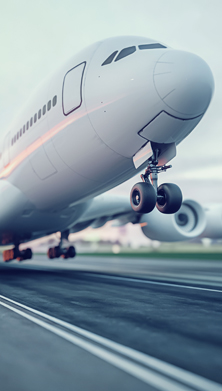The global population depends on a safe and efficient commercial aviation network. Since the launch of scheduled commercial aviation operations 100 years ago, through the beginning of the jet age 60 years ago, to the present day, stakeholders in the aviation industry have worked continuously to improve the sector’s safety performance.
The global population depends on a safe and efficient commercial aviation network. Since the launch of scheduled commercial aviation operations 100 years ago, through the beginning of the jet age 60 years ago, to the present day, stakeholders in the aviation industry have worked continuously to improve the sector’s safety performance.
With some 58 million jobs across the globe and $2.4 trillion in economic activity dependent on the aviation sector1, its safety is critical to the health of the global
economy. It is estimated over a third of the value of goods traded internationally are delivered by air. Moreover the industry is growing.
By 2050 it is estimated that some 16 billion passengers – equivalent to more than double the current global population of around seven billion – will need to be flown yearly2, an anticipated increase of 384% compared with the 3.3 billion passengers expected to fly during 20143. In 1960 just 106 million passengers flew worldwide. In 2014, 50 million tons of freight will be flown across almost 50,000 routes4. By 2050 this is expected to increase significantly to 400 million tons5.
Aviation incidents will always captivate both media and public attention as 2014’s tragic and extraordinary activity has demonstrated – by the end of August three of the 10 major non-natural catastrophe insurance losses of 2014 could be attributed to plane crashes. However, the recent air disasters don’t necessarily reflect any major systemic problems with safety. This year’s loss activity is contrary to the low catastrophe rate of recent years with 2012 ranked as the safest year of flying since the beginning of the jet age in 1952.
Although the aviation sector has experienced robust growth since the dawn of this era, the past 60 years have seen an ongoing decline in fatal accidents, underpinned by a continuous improvement in safety.
There are currently fewer than two passenger deaths for every 100 million passengers on commercial flights. By comparison during an early decade of the jet age, (1962 to 1971), there were 133 passenger deaths out of every 100 million passengers. Overall analysis of aviation safety shows improvement in every decade since the 1950s.
In 1959 an individual would face the chance of being in a fatal accident once out of every 25,000 departures in the US and Canada. Today, the odds of dying in a crash aboard an airplane in the US or the European Union are calculated to be 1 in 29 million. The odds of being killed by lightning are 1 in 10.5 million. The odds of dying while riding a bicycle are 1 in 340,000 or about 100 times greater than flying.
Improvement drivers
The long term improvement in global airline safety is due to a combination of several positive trends. Aircraft have become more reliable while safety systems and culture have improved enormously. At the same time the standard of training of crew has become notably higher. Improved air traffic control technology and better collision avoidance systems have also impacted.
Pilots now have much more live information at their fingertips, including more accurate and up-to-date weather data. Safety inspections are now far more effective. Aircraft inspections are much more detailed and stringent than in the past and have been quick to incorporate improved technologies.
This means problems are increasingly being identified and dealt with long before they become a significant issue. Another major factor has been the increased use of recurrent training, which refreshes the skills of pilots and crew, as well as helping them prepare for unusual or emergency situations. This had a significant impact in reducing accidents and therefore insurance claims.
Regional variations in safety
Aviation safety varies across different regions of the world. The state of industrialization is often related to the safety of that region. The Africa region is the poorest performer with standards in some of the more remote parts of the continent, comparable to those of 50 years ago in the US or Europe.
More than one-fifth of the world’s air accidents occurred in Africa in 2011. In 2012 88% of global aviation fatalities occurred in Africa (45%) and Asia (43%). Africa currently uses the highest percentage of second generation aircraft – over 50% of the total fleet analyzed. Upgrading the airline fleet to current generation aircraft is one of the safety initiatives which have lowered the global accident rate.
However Africa was one of the regions which saw its safety performance improve last year compared to 2012. Latin America and the Caribbean was the other. North Asia and Europe were unchanged. CIS had the worst performance after having no Western-built jet losses in 2012.

Ongoing challenges
Regional accident rates can be hard to calculate and compare. Many different agencies or states have varying definitions. In addition, in some cases, foreign civil aviation authorities misreport their compliance with international aviation standards.
There are regional differences. In some parts of the world human factors, safety awareness and training are a bigger risk than in others. In some developing countries where modern equipment and aircrafts are in use, the pilots and ground crews do not quite have the same level of training as for example in Europe and North America.
Improved aviation technology and training has led to a higher level of air safety in the US and elsewhere. However, this also means many people in the aviation industry have not been involved in a major accident. This lack of experience is one of the biggest problems in emergency response preparation.
A number of high-profile incidents have raised the question of whether pilots are too reliant on automation in the cockpit. Pilot training has changed and improved, but more focus should be placed on continuous training with pilots flying with and without automation. There has to be better preparation of pilots to fly and recover the aircraft if the automation fails. It is clear that improvements have to be made. Pilot training needs to be changed to address this issue.
Insurance impact
The much-improved safety environment is reflected in the fact that premiums for aviation insurance were at their lowest levels for many years, prior to 2014’s loss activity.
However, there has been a 50%-plus increase in exposure (ie the potential loss) since the turn of the century, driven by increasing fleet values and more passengers. Exposures increased from $576bn in 2000 to $896bn6. This means that if exposure growth continues at the same rate, we can expect it to break through the $1trn barrier by 2020 or even earlier.
In analysis of large insurance claims in excess of $1.36m (€1m), unsurprisingly, plane crashes are the major cause of loss for the aviation sector in terms of number of insurance claims generated (23%) and their subsequent value (37%). Over/undershot runway incidents ranked second according to value (22%). Almost a fifth (18%) of aviation claims relate to ground handling claims and 16% to mechanical failure.
Huge improvements in aviation safety may be leading to fewer catastrophic losses over the long term but technology brings its own vulnerabilities with the cost of aviation claims rising, driven by the widespread use of new materials, as well as ever more-demanding regulation and growth of liability-based litigation.
Composite repairs require the relevant expert technicians, often in limited supply. As a result, new generation aircraft take more time to assess damage and repair, leading to more down time and more expense. At the same time, the cost of repairing older aircraft is also increasing. Aging fleets are more expensive to repair as the availability of parts becomes more problematic.
Emerging risks
Intensified competition and market stagnation/decline, natural hazard risk, regulatory change and technological innovation also rank highly on the risk register. Threat of terrorism is an increasing concern year-on-year based on initial findings from the upcoming Allianz Risk Barometer 2015.
Scientists have found turbulence will increase in the North Atlantic flight corridor in future due to the changing climate. The chances of encountering significant turbulence could increase by between 40% and 170% on the flight corridor, where 600 jets travel each day. More severe episodes can injure passengers and cause structural damage to planes, costing an estimated $150m a year.
Cyber attacks could become the “weapon of choice” against the aviation community. There is increasing concern about the impact a large scale cyber attack could have given the sector relies on computer systems for almost every aspect of its business. Data breaches and cyber terrorism are perceived to be growing risks. New generation aircraft face increasing threats due to the more prevalent use of data networks, computer systems onboard and navigation systems. Indeed, the whole sector is facing major cyber risks on all fronts.
Pilot shortage, the threat posed by lithium batteries in flight and the expected increase of unmanned aerial vehicles (UAVs) in commercial use are among the other emerging risk trends to watch.
Damage from foreign objects continues to be an issue, with this being the fifth highest generator of insurance claims by number. Bird strikes are a notable cause of loss in this area, with claims also arising from incidents with zebras and cows. Attempts are being made to reduce such incidents happening.
SOURCES
1. IATA annual review 2014
2. IATA Vision 2050
3. IATA annual review 2014
4. IATA annual review 2014
5. IATA Vision 2050
6. Aon Airline Insurance Outlook 2014















